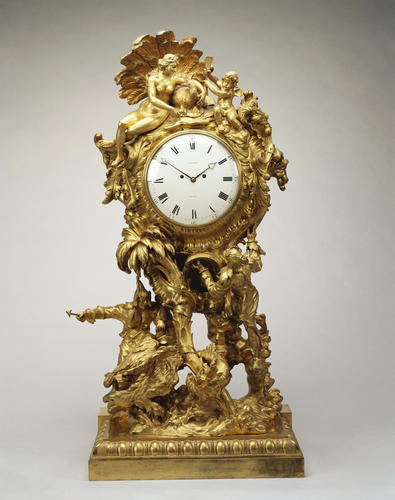-
1 of 253523 objects
Mantel clock 1720-60
Chased gilt bronze, blued steel, enamel | 123.0 x 61.0 x 33.0 cm (whole object) | RCIN 2770
-
A monumental assymetrical gilt bronze mantel clock of cartel shape. On the rocky base is a dragon (with dart shaped tail and tongue) entwined around a palm tree with a chinoiserie figure to the left confronting the beast with a spear (now missing). To the right Mars, gazing aloft, climbs a tree attempting to reach the crest of the clock where a group comprising Venus, her peacock with its tail outspread - representing love - and Cupid brandishing a paddle. All mounted on a rectangular stepped base with symmetrical moulding. The case is composed of numerous castings, the quality of which are variable; some are braised one to the other and others secured by straps and screws. The case has been ascribed to Antoine Sebastian Slodtz (1655-1726) who held a royal appointment as designer to Louis XV but there is no evidence to substantiate this attribution. According to the original receipt the movement in the clock on delivery was by Claude Ragut, a clockmaker working in Paris between 1785-90; he became a maître in 1785 and had premises in the rue St. Denis in 1789. Given the dates of Ragut's activities it is suggested that this movement replaced an original from the time when the clock was made c.1750. Benjamin Lewis Vulliamy charged £550 for the delivery of the clock which suggests he may have acted as the Prince Regent's agent in Paris for its acquisition. He also charged £31 10s. for a replacement mechanism; this consists of an eight-day rack striking clock with fusee movement and a ½-dead beat escapement. The enamel face has the 12 hours represented in Roman figures and the minutes in arabic numerals with a pair of Vulliamy blued steel pierced spade hands. Vulliamy number 739
Provenance
Purchased in Paris and despatched to London where it arrived on 6 October 1819. Sent to the Royal Pavilion, Brighton, by 'Road Waggon' on 13th October 1819. There it remained until the sale of the Pavilion in 1846 by Queen Victoria when it was consigned to Windsor following Queen Victoria's decision to sell the Royal Pavilion in 1846. It is no.3 in a 'List of Clocks, Shades Etc packed at the Pavilion Brighton 1846. Delivered by Mr. Tupper to Windsor Castle. 6 Jan 1847' and described as 'A Clock in a massive ormolu antique French case'.
-
Creator(s)
(clockmaker (movement))(nationality)Acquirer(s)
-
Medium and techniques
Chased gilt bronze, blued steel, enamel
Measurements
123.0 x 61.0 x 33.0 cm (whole object)
Object type(s)
Alternative title(s)
The Rock clock
